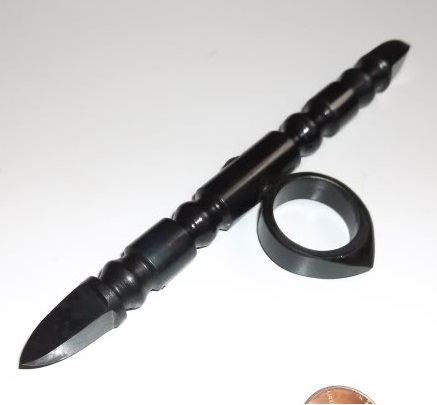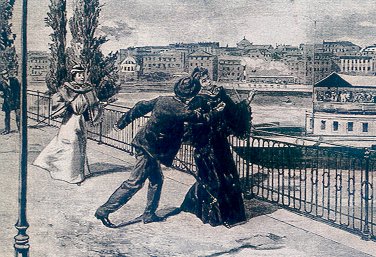|
Emeici
''Emeici'' (峨嵋刺; variously translated as " Emei Daggers", "Emei Piercers") are a traditional Chinese martial arts weapon. They are a pair of metal rods with sharp ends used for stabbing; they are typically mounted on a detachable ring worn on the middle finger, allowing them to spin and be elaborately manipulated. These weapons originated at Mount Emei (hence the name). They are a piece of equipment used in wushu to this day. These weapons are used for 'open palm' techniques, and are similar to 'judge's pens'. The general idea of this weapon is to confuse the attacker by spinning the blades, thereby providing a distraction while trying to get close enough to stab. Also, emeici can be concealed easily for surprise attacks. See also * Suntetsu - a similar Japanese weapon. * Shobo - a similar Japanese weapon. {{martialarts-stub Chinese melee weapons ... [...More Info...] [...Related Items...] OR: [Wikipedia] [Google] [Baidu] |
Shobo
A ''shobo'' is a weapon, similar to the Emeici of China, which was used by the ninja of Japan for striking pressure points on an opponent. It was a piece of wood that was gripped by the wielder and was hung by a ring worn on the middle finger. Some versions were rings with a wooden peg attached on top. The ends were exposed and were usually sharp, which made them effective for paralyzing and even killing enemies quickly and without leaving a trace. They were easily hidden in the fists and were very lightweight and portable. They were usually worn in pairs. Many ninjas constructed their own shobo, although some were given from master to student. Due to the secretive nature of the ninja, there is no way of knowing exactly when and where the shobo was invented (meaning no more precise than feudal Japan The first human inhabitants of the Japanese archipelago have been traced to prehistoric times around 30,000 BC. The Jōmon period, named after its cord-marked pottery, was fo ... [...More Info...] [...Related Items...] OR: [Wikipedia] [Google] [Baidu] |
Wushu (sport)
''Wushu'' (), or ''Kung fu'', is a hard and soft and complete martial art, as well as a full-contact combat sport. It has a long history in reference to Chinese martial arts. It was developed in 1949 in an effort to standardize the practice of traditional Chinese martial arts, yet attempts to structure the various decentralized martial arts traditions date back earlier, when the Central Guoshu Institute was established at Nanking in 1928. "''Wushu''" is the Chinese term for "martial arts" (武 "Wu" = combat or martial, 術 "Shu" = art). In contemporary times, Wushu has become an international sport under the International Wushu Federation (IWUF), which holds the World Wushu Championships every two years. Wushu is an official event at the Asian Games, East Asian Youth Games, Southeast Asian Games, World Combat Games, and in various other multi-sport events. Name The word wu (武; wǔ) means ‘martial’. Its Chinese character is made of two parts; the first meaning � ... [...More Info...] [...Related Items...] OR: [Wikipedia] [Google] [Baidu] |
Suntetsu
The is a Japanese concealed weapon Concealed carry, or carrying a concealed weapon (CCW), is the practice of carrying a weapon (usually a sidearm such as a handgun), either in proximity to or on one's person or in public places in a manner that hides or conceals the weapon's pre .... A suntetsu is a metal rod/spike about 15 cm in length with a ring attached to it. The middle finger is inserted into the ring and the suntetsu rests in the hand by various grips. Suntetsu are small, easy to conceal and relatively simple to learn how to use. Suntetsu are used for stabbing, poking, pinching, striking, smashing, scraping and throwing. Suntetsu can be used alone or as a pair. See also * Emeici - a similar Chinese weapon. * Shobo - a similar Japanese weapon. Weapons of Japan {{martialart-stub ... [...More Info...] [...Related Items...] OR: [Wikipedia] [Google] [Baidu] |
:Category:Chinese Words And Phrases
This category is for articles on words and phrases of Chinese origin. For articles on words and phrases related to a specific area of China, or to a specific spoken variant, please refer to one of the subcategories. Words A word is a basic element of language that carries an objective or practical meaning, can be used on its own, and is uninterruptible. Despite the fact that language speakers often have an intuitive grasp of what a word is, there is no conse ... Words and phrases by language {{CatAutoTOC ... [...More Info...] [...Related Items...] OR: [Wikipedia] [Google] [Baidu] |
Mount Emei
Mount Emei (; ), alternately Mount Omei, is a mountain in Sichuan Province, China, and is the highest of the Four Sacred Buddhist Mountains of China. Mount Emei sits at the western rim of the Sichuan Basin. The mountains west of it are known as Daxiangling. A large surrounding area of countryside is geologically known as the Permian Emeishan Large Igneous Province, a large igneous province generated by the Emeishan Traps volcanic eruptions during the Permian Period. Administratively, Mount Emei is located near the county-level city of the same name (Emeishan City), which is in turn part of the prefecture-level city of Leshan. It was made a UNESCO World Heritage Site in 1996. As a sacred mountain Mount Emei is one of the Four Sacred Buddhist Mountains of China, and is traditionally regarded as the bodhimaṇḍa, or place of enlightenment, of the Bodhisattva Samantabhadra. Samantabhadra is known in Mandarin as Pǔxián Púsà (). Sources of the 16th and 17th centuries ... [...More Info...] [...Related Items...] OR: [Wikipedia] [Google] [Baidu] |
Stabbing
A stabbing is penetration or rough contact with a sharp or pointed object at close range. ''Stab'' connotes purposeful action, as by an assassin or murderer, but it is also possible to accidentally stab oneself or others. Stabbing differs from slashing or cutting in that the motion of the object used in a stabbing generally moves perpendicular to and directly into the victim's body, rather than being drawn across it. Stabbings today are common among gangs and in prisons because knives are cheap, easy to acquire (or manufacture), easily concealable and relatively effective. In 2013, about 8 million stabbings occurred. History Stabbings have been common throughout human history and were the means used to assassinate a number of distinguished historical figures, such as Second Caliph Umar and Roman dictator Julius Caesar and emperor Caligula. In Japan, the historical practice of stabbing oneself deliberately in ritual suicide is known as ''seppuku'' (more colloquially ''har ... [...More Info...] [...Related Items...] OR: [Wikipedia] [Google] [Baidu] |


